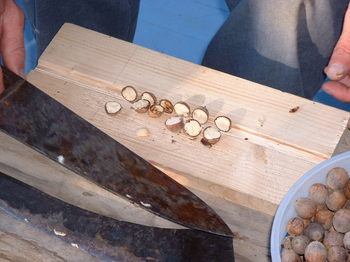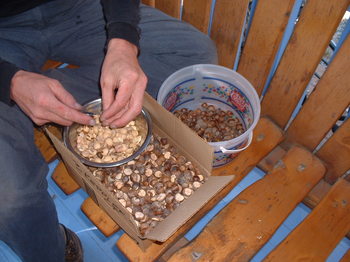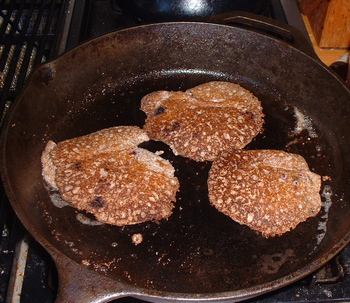Wildcrafting: the acorns are early, start saving up for winter now

Time to stock up on acorns for the winter. The meats are nutritious, pleasant tasting and useful as flour. It just takes a bit of work to remove the tannins and make into flour.
Linda Diane Feldt | Contributor
On thing is that my dog likes acorns, and will eat the meat inside - even without rinsing them. If I leave a bag of gathered acorns within reach, she'll dump them and eat a few.
I also found that the acorns from white oaks have less tannin, so they're easier to rinse with plain tap water just a few times. It is the red and black oaks that need more extensive rinsing, and are better candidates for using a toilet tank. You'll have to read last year's article to understand.

The outer shell is easy to remove, leaving the meats. Remove any wormy or damaged parts, grind, rinse, and dry. You then have acorn flour, easy to use in quick breads and pancakes.
Linda Diane Feldt | Contributor
I also learned that it is better to process them now, rather than later. Acorns lose taste and are harder to work with if stored whole. My preference now is to do the work soon after collecting, make the flour and freeze it. It has more aroma and taste that way.

My favorite - acorn flour pancakes with black raspberries.
Linda Diane Feldt | Contributor
My favorite use is pancakes. Last year, my foraging friend and I also gleaned buckwheat and hulled that and ground it for flour. I wrote about this meal before, but I will repeat myself and remember that special breakfast of pancakes made from local acorn flour, the gleaned buckwheat made into flour, local eggs and milk, homemade butter and homemade maple syrup, with black raspberries as well, also picked nearby and frozen.
I hope you can enjoy a breakfast that special sometime soon.
Linda Diane Feldt is a Holistic Health Practitioner, teacher, and writer. You can follow her on twitter, find her website, or contact her directly ldfeldt (at) holistic wisdom.org
Her free class on herbal wisdom will begin again in September, beginning the 18th year of the series, sponsored by The People's Food Co-op.


Comments
Rork Kuick
Thu, Aug 19, 2010 : 8:50 a.m.
The blog Ed pointed to talks about germinating the seed. Taste for yourself - they get much sweeter. Deer hunters notice certain things. The cycles of good and bad years for our red, pin, black, white, burr and swamp-white oaks are interesting and not always synchronized (I'm using "red" and "white" to refer to particular species now, not large groups of species). Most oaks out there in the Waterloo/Pinckney are red and white oaks, and had poor seasons last year, and not too great the year before, so I am expecting, perhaps hoping, and think I am seeing, that they will be great this year. Swamp-whites were the best trees last year, but they are only in certain places. Some areas (Island Lake rec area) hold some almost pure stands of black oaks, but I haven't checked lately. In town, trees in nice locations have pretty good years nearly every year, but even so, you can tell that the red oaks are particularly loaded now. Maybe I detect that our shagbark hickories are having a bad year. Most years my nut loving rodents (chipmunks and 4 species of squirrels) work them to pieces before they turn to the white oaks, and later the reds and blacks, and that is just not happening. Our hickories, and the history of pecans, are rather interesting. The nuts of local shagbarks can be outstanding, and are fun to work on with kids. They are quite difficult though. Compare several trees before getting too serious since size and difficulty of cracking is quite variable, and certainly be able to distinguish the 4 species around here. Another hard part is to get them before the other animals do, a problem I have even worse with hazelnuts (yup, they grow around here, sometimes in great masses). I haven't tested our shell-barks (the ridiculously shaggy ones in wetter locations).
krc
Wed, Aug 18, 2010 : 9:55 a.m.
They are early? Makes me wonder if this is a sign that we're going to have a severe winter.
dextermom
Wed, Aug 18, 2010 : 7:14 a.m.
No need to pilfer - I'll bet your neighbor is like me and would love to have you rake them up!
A2K
Tue, Aug 17, 2010 : 2:41 p.m.
This article is making me want to re-read the childhood classic "My Side of the Mountain"...the main character makes acorn meal pancakes with wild blueberry jam. Mmmm~ I'll have to see if our neighbors will let me pilfer some acorns from their oak trees :O)